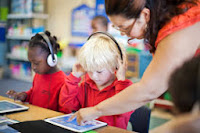Sunday, July 20, 2014
Wednesday, July 16, 2014
Blog Post 14 and 15- That's A Wrap!
Some final uses of technologies that were introduced with us included QR Codes. QR Codes can be used as a tape recorder. Teachers can record their voice for students, as well as students can record their own voice for themselves as well. The teacher can essentially become a personal tutor for the student this way. After recording, you can turn the recording into a URL, this way it is accessible to all students.
Three helpful classroom tools that are good for reading include Ipad Centers, Poplet Centers, and the Alabama Virtual Library. In an Ipad Center, students can record themselves reading, after reading the child listens with the recording and makes sure he or she did not make any errors upon reading the first time. This allows self correction for the student. Poplet is an app you can download to Ipads. First, students are to choose a book, and once they have done that they can use the app to add pictures, information, and text to create a digital bubble map to use as a visual tool for their reading. Also, the Alabama Virtual Library is an app students can also download onto their app Ipads. The student is then able to type in a word, then the student is read, by the app, an introduction and facts to whatever the word they typed in.
Also, we were to watch a video instructing how to make an Imovie relevant within the classroom. I personally loved using Imovie for the book trailer we made in an earlier assignment. It is definitely something I would incorporate into my classroom as an English teacher. The fact that students as young as six years old are able to use it is truly amazing, and says something about the correlation between upcoming generations and technology. A final type of app we learned about was Discovery Education Board Builder this is an app students are able to use to create their own educational board, they are able to add pictures, facts, and links from Discovery Education to their board. This can be used as a study technique for themselves or shared amongst their peers.
One of the final videos we watched was an interview directed by Dr. Strange about Twitter For Educators In this video, it was discussed how Twitter is changing the way teachers are learning. Through sites like twitter and technology, we all become learners. Education is no longer just a teacher teaching a students, but now everyone, including teachers, are able to now become full time learners. Everyone can learn something from everyone.
C4Tp #4 (Silvia Tolisano)
In an earlier blog post, Telling a Story With Data Ms. Tolisano introduces a class in which the students have learned to take data, analyze the data and tell a story with it. They are demonstrating their understanding of Math concepts, data graphs, misleading graphs and communication skills. The students were given a rubric, so expectations were clear, then students were able to let their creativity flow, by changing the math into a story to share with their class.
C4Ta Post #4 (William Chamberlain)
In an earlier post, Owning Our Choices and Accepting Ourselves, Chamberlain discusses a project being held within his classroom. The students are instructed to create their own "Russian nesting doll," a week later, the students will explain why they created the doll the way they did, why they chose a super hero, friend, etc... The point of this project is to encourage individuality. Educators should encourage individuality, and allow students the opportunity to be creative without the presence of peer pressure. As Chamberlain says, " We need to take a stand in our classrooms and give our students opportunities to share their inner nerdiness. Give them their voice."
Sunday, July 13, 2014
Blog Post 13- What Did I Leave Out?
In this weeks blog, you need to find three useful tools, not discussed in earlier assignments, on the SMARTboard that could be used for English class specifically.
Once you have found the three tools, give a short synopsis of how you would incorporate theses tools into three different lesson plans.
A useful site to use is SMART EXCHANGE
Wednesday, July 9, 2014
Sunday, July 6, 2014
C4Tp Post #3 (Silvia Tolisano)
In Silvia Tolisano's blog, "Documenting FOR Learning", she discusses the importance of documentation for teachers and students. She gives many effective examples of how to document in the classroom, such as, video, blogging, and photos. I also agree documentation is important, not only does it help students to more easily retain information, but it also allows for better organization within the classroom.
C4Ta Post #3 (Steven Anderson)
A second blog post Mr. Anderson wrote was entitled, "Quick Collection of Bring Your Own Device Resources." In this blog post, Anderson addresses the fact that, yes, allowing students to bring their own type of device to class may originally seem overwhelming to the teacher. However, their are many great resources found online that can offer helpful apps, ideas, and tools to allow teachers to handle multiple devices brought by the students. These resources can be found on sites, such as, Edutopia, THE Journal, and many other online options for great tips for teachers.
Saturday, July 5, 2014
Blog Post 11- What Can We Learn From These Teachers?
In Paul Anderson's video, Blended Learning Exercise, he discusses what exactly blended learning is. Blended learning is a blend of online, mobile, and classroom learning into one. The six stages to an effective blended lesson, according to Mr. Anderson, are to Question, Investigate, Video, Elaboration, Review, and Summary Quiz. In a later video, 5th grade teacher, Mr. Sam Pane, discusses the importance of Teaching Digital Citizenship to your students. When incorporating lesson plans which involve the use of internet, it is important to teach students necessity of proper etiquette online. They should be aware of potential identity thieves, so students must keep their information private. Also, students must be aware that what they post online is available for all of the world to see. Lastly, in Dean Shareski's video, Project Based Learning, the benefits of combining multiple classes for PBLs is shown. In this video, History, English, and Information Processing were all combined to preform effective PBLs. This type of learning allows students to make connections within the classroom and be productive within their own learning.






